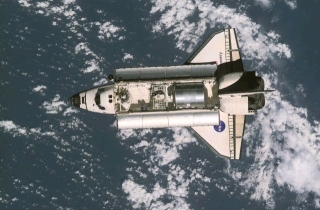January 8, 2006
Intelligence Briefing:
Revolution & Terrorism
The Foam That Ate the Space Shuttle?
Part 1: Blaming Anything but Terrorism
 |
NASA |
An Earlier Mission: Shuttle Discovery, August 2001 |
Last July, after the space shuttle Discovery was already in orbit, it was learned that several pieces of foam had fallen off during blastoff. One was larger than the piece that had supposedly destroyed Columbia in 2003, and another had been confirmed to have struck the shuttle’s wing.
NASA announced all future shuttle flights were grounded for the time being. “I was frankly mortified at the performance of the foam and we would not fly again until we fix it,” declared Deputy Shuttle Program Manager N. Wayne Hale, Jr.1
The shuttle crew, on the other hand, seemed pretty nonchalant. After some obligatory checking, they found nothing to concern them. Several days later they landed back on earth without a problem. It was as if no NASA expert actually expected any real problem.
They had good reason not to worry. It turns out that foam pieces falling and striking the shuttle orbiters are nothing new; in fact, most shuttle flights — approximately 60% — have experienced foam loss during the program’s 114 flights.2 In October of 2002, shortly before the Columbia disaster, the solid rocket booster of shuttle Atlantis was damaged by a chunk of foam without serious consequences.3 According to news reports, “Pieces of foam… have detached and struck the shuttle on six previous missions and investigators believe three other incidents may have occurred at night or when the shuttle could not be photographed.”4
Foam isn’t the only debris bombarding the shuttles; ice, flecks of paint, and other particles leave an average of 150 nicks and gouges on the shuttle’s tiles during each flight.5 A 1988 mission of shuttle Atlantis left more than 250 damaged areas on the orbiter, while 244 hits marked shuttle Columbia in December, 1996. On that Columbia mission, “109 left gouges larger than 1 inch” and “the largest measured 15 inches.”6 NASA officials say there may have been much more “unobserved” damage on orbiters all along.7
And all this never even came close to destroying a single shuttle. So did it doom the Columbia mission on February 1, 2003?
The notion that a small piece of light foam would somehow devastate the space shuttle — a rugged, reinforced machine with multiple backup systems for every possible emergency, which had stood the test of 22 years of reliable service — struck the experts as absurd from the very beginning. North Carolina Foam Industries, the foam’s producer, denied any such possibility.8
So did NASA’s best engineers. “‘It does not make sense that a piece of [foam] would be the root cause of the loss of the Columbia and the crew. We don’t believe it’s the chunk of foam,’ Ron Dittemore, NASA’s space shuttle program manager, said at the Johnson Space Center. ‘It’s got to be something else. We are focusing our attention on what we didn’t see.’”9
What they “didn’t see” was the more realistic prospect of terrorism, an explanation dismissed much too quickly by non-NASA political interests.
Even if Columbia was destroyed by a hole in its wing, itself an unproven hypothesis, NASA scientists originally maintained something other than foam had to breach the wing. Evidence of such a hole “still doesn’t tell you how the hole occurred,” pointed out one former shuttle astronaut.10 Among the tantalizing bits of evidence was the change of colors of the hot plasma shooting past the shuttle during its reentry into the atmosphere, an indication of some traumatic event during its descent.11 Could this reflect sabotage, or perhaps a bomb detonation?
This entire direction of inquiry dropped into a black hole somewhere between the NASA experts and political halls of power. Instead, the investigation was deliberately sidetracked into blaming the foam, regardless of evidence — and even when the evidence clearly proved otherwise.
References
1. Johnson, J. Jr., “Foam bit might have hit right wing,” Los Angeles Times, July 29, 2005, p. A24.
2. Reuters, “NASA blames application of foam for shuttle disaster,” Los Angeles Times, Aug. 14, 2004, p. A14.
3. Vartabedian, R., “Foam issue may delay resumption of shuttle flights,” Los Angeles Times, June 22, 2003, p. A18.
4. Vartabedian, R., “Near proof of shuttle’s fatal flaw,” Los Angeles Times, May 7, 2003, pp. A1, A19.
5. Johnson, J. Jr., Op cit.
6. Vartabedian, R., “Report likely to say NASA minimized foam peril,” Los Angeles Times, Aug. 26, 2003, pp. A1, A16.
7. Johnson, J. Jr., Op cit.
8. Gold, S., “Board nearing judgment on shuttle disaster,” Los Angeles Times, April 23, 2003, p. A15.
9. Gold, S. & Malnic, E., “NASA says tank foam not to blame,” Los Angeles Times, Feb. 6, 2003, pp. A1, A24.
10. Gold, S. & Vartabedian, R., “Breach in shuttle suspected,” Los Angeles Times, Feb. 14, 2003, pp. A1, A22.
11. Gold, S. & Malnic, E., Op cit.